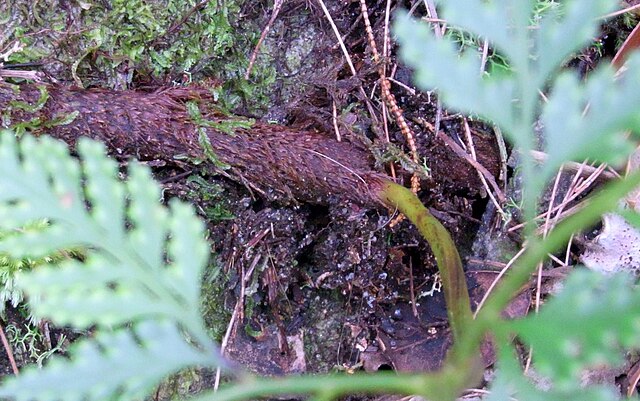Top Qs
Timeline
Chat
Perspective
Davallia
Genus of ferns From Wikipedia, the free encyclopedia
Remove ads
Davallia (deersfoot fern, hare's foot fern, shinobu fern, rabbit foot fern, ball fern)[citation needed] is a genus of about 40 species of fern. In the Pteridophyte Phylogeny Group classification of 2016 (PPG I), it is the only genus in the family Davalliaceae, which is placed in the suborder Polypodiineae, order Polypodiales.[1] Alternatively, the family may be placed in a very broadly defined family Polypodiaceae sensu lato as the subfamily Davallioideae.[2]


The family is sister to the largest family of ferns, Polypodiaceae,[1] and shares some morphological characters with it.[3] Species are epiphytic ferns, with fronds arising from long aerial rhizomes which grow on and over thick bark on trees or on rock crevices.
Remove ads
Description
Usually epiphytic or epipetric. Rhizomes dictyostelic, dorsiventral, densely scaly. Stipes articulate at base. Phyllopodia short. veins free. Sporangium stalk 3-rowed. Annulus vertical. Spores monolete.[citation needed]
Taxonomy
Summarize
Perspective
Gymnogrammitis and Leucostegia were once included in Davalliaceae, but these are now known to belong elsewhere. Gymnogrammitis is in a clade with Selliguea and others in the family Polypodiaceae.[4] Leucostegia is in the family Hypodematiaceae,[5] which consists of Hypodematium and Leucostegia,[6] and possibly Didymochlaena as well.[7]
In 2008, a molecular phylogenetic study of Davalliaceae showed that none of the polyspecific genera recognized at that time were monophyletic.[8] In that same year, a revision of the family divided it into five genera.[5] One of these, Araiostegiella, was newly described. The genus Davallia was divided into two sections, named Davallia and Trogostolon. Based on molecular phylogenetic studies, the Pteridophyte Phylogeny Group classification of 2016 (PPG I) accepts only one genus in the family, Davallia, sinking the other genera into synonymy.[1] The study on which the PPG I circumscription is based divides the genus into seven sections.[9]
Phylogeny
The following cladogram for the suborder Polypodiineae (eupolypods I), based on the consensus cladogram in the Pteridophyte Phylogeny Group classification of 2016 (PPG I),[1] shows a likely phylogenetic relationship between Davalliaceae and the other families of the clade.
Other species include:[citation needed]
- †Davallia aspera Botscharnikova 1960
- Davallia brevipes Copeland 1906
- †Davallia bullatiformis Chlonova 1960
- †Davallia cavernosa Botscharnikova 1960
- Davallia dimorpha (Copeland) Holttum 1937
- †Davallia haidingeri von Ettingshausen 1858
- Davallia kinabaluensis (Copeland) Chen 2017
- Davallia leptocarpa Mettenius ex Kuhn 1869
- †Davallia mantellii (Brongniart 1828) de Saporta 1891
- †Davallia montana Knowlton 1899
- Davallia napoensis Wang & Xing 2011
- Davallia pusilloides (Copeland) Parris 2018
- Davallia rouffaeriensis Nooteboom 1994
- Davallia seramensis Kato 1989
- Davallia serrata Willdenow 1810
- Davallia sessilifolioides Kato 1989
- †Davallia solidites Graham 1963
- Davallia speciosa Mettenius ex Kuhn 1869
- Davallia subvestita (Christensen) Parris 2018
- Davallia wagneriana Copeland 1905
Selected species
Many of the species of Davallia are closely related and hard to distinguish from each other. In 1990, a treatment of Davalliaceae estimated the number of species at 110.[3] A 2008 paper listed all of the species, recognizing only 63.[5] A new species, Davallia napoensis was described in 2011.[12] The Pteridophyte Phylogeny Group classification of 2016 (PPG I) suggests there are about 65 species.[1]
- Davallia bullata - Japan, China, and tropical Asia.
- Davallia canariensis - Macaronesia, Iberian Peninsula and Morocco.
- Davallia denticulata - Africa, India, China, Malesia, Indonesia, Polynesia, Australia
- Davallia divaricata (syn.: Davallia polyantha) - Tropical Asia.
- Davallia embolostegia
- Davallia fejeensis Hook (syn.: Davallia fijiensis) - Fiji Islands and Australia.
- Davallia mariesii or "Squirrel's-foot fern" – tropical Asia and Malaysia
- Davallia pectinata
- Davallia repens
- Davallia solida - Sri Lanka, tropical and subtropical Asia (east Himalaya to Southeast Asia and China), eastern Australia, and Pacific Islands[13]
- Davallia solida var. pyxidata - New South Wales
- Davallia solida var. fejeensis (Hook.) Noot. - endemic to Fiji
- Davallia solida var. solida
- Davallia tasmanii - Davallia fern, native to the Three Kings Islands.
- Davallia trichomanoides (syn.: Davallia dissecta) - Malaysia.
Remove ads
Distribution and habitat
Davalliaceae is native to tropical and subtropical regions of the Pacific, Australia, Asia, and Africa.[14] Plants are usually epiphytic, sometimes lithophytic or terrestrial.
Davallia as house plants
Many species of Davallia are in cultivation,[15] with Davallia tyermanii, Davallia fejeensis, and Davallia solida being perhaps the most well-known.[16] A key to the cultivated species of Davallia is available.[17] D. polypodiaceae, D. canariensis and D. trichomanoides are also grown as ornamental plants.[18] D. fejeensis is the most common Davallia species in commerce, and D. canariensis is widely grown as a house plant.[18]
The plants have furry rhizomes which cover the surface of the potting mixture as well as root down into it. The fronds are triangular in shape and about 1½ feet long by 1 foot wide. They divide into three to four pinnae which subdivide into many pinnules. Davallia are often used in hanging baskets because the rhizomes split into sections and the surface is covered quickly. Unlike other ferns, Davallia tolerate low levels of humidity.[19]
Remove ads
References
Wikiwand - on
Seamless Wikipedia browsing. On steroids.
Remove ads

